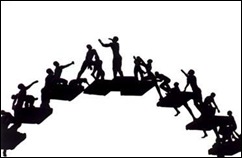Before continuing my exploration of how “doing away with the coursebook” would influence teaching special needs children such as the ones I teach, just a quick look at the status of the previous two angles explored:
* Readers’ comments have made me feel much better about recycling vocabulary in a class without a coursebook (“Angle 2”)
* I remain as concerned as ever about the mainstreamed special-needs children and their tutors (“Angle 1”).
And now for “Angle 3” !
I teach a lot of reading & writing skills by having students answer questions about pictures.
I work on reading & writing skills by doing “Reverse Reading” activities on the board.
Students participate in the Y.A.L.P vocabulary project.
Sometimes we play games.
These are all activities done without the coursebook.
Then along comes the pupil who flips through his coursebook and says :”Look how many exercises we’ve skipped! We haven’t learned anything this year!”
The more ambitious the students, the more they are concerned about comparing their progress to something clear and unambiguous. They can look at their grammar book and see which tenses /structures they’ve drilled. They can see which pages they have filled in their coursebook. The Y.A.L.P vocabulary project has its own tracking page which shows progress.
Progress in reading and writing activities cannot be measured in such a manner.
This morning I was explaining to a group of tenth graders about the different levels of the national exams in English they would be taking next year. In the easier exams the students can copy a sentence from the text as an answer but the harder ones require the students to actually form the answer on their own. This prompted one very ambitious, smart and tense girl (profoundly deaf, too) with a “horribly low” level of vocabulary,to accuse me of not teaching them how to write this year…

Hi Naomi,
Do your students have a portfolio? We have folders for each of our YLs this year and they’ve really enjoyed seeing how it has expanded throughout the year – they’re now each about 1cm thick. It could work especially well for writing as the students have something tangible to look at which they can see physically growing. Not sure what I’d do about the reading though.
Sandy
Hi Naomi,
I teach adults and teens so my situation is slightly different, but I usually set up portfolios for my learners to keep as well (either digital, or paper-based).
If we’re using paper-based portfolios, I hand out files for them to keep their work in at the start of term, and put a “can do” checklist at the back of each file, so they can measure their progress as we go along and see what they have achieved.
From a teacher perspective, portfolios can be useful too, as you can collect them in from time to time and get an overview of how your learners are doing.
Sue
Sandy and Sue!
Thank you both so much for taking the time to comment!
From both of your comments (and my student’s comment yesterday!) it seems that even if I elect to continue what I am doing now (using a coursebook but very “loosely” with a lot of unrelated activities) a portfolio would be a helpful addition.
Sue: What kind of “can do” list would you use for reading comprehension? Writing is easier to define (used correct tense, articles, etc.).
Lots to think about this summer!
Hi again, Naomi!
My “can do” lists tend to be heavily personalised, so it’s difficult to say… I generally have a one-to-one with learners early on in the course, and we draw up a “can do” list together, which may be revised at any point as we go along, if needs be.
With adult learners, the reading outcome can be something as simple as “I would like to progress to the next level of graded readers”. I don’t have any experience of teaching ELT to YL’s, though I do sometimes teach adults with learning disabilities and/or additional learning needs. Probably the best advice I can give you is to personalise as much as possible, keep things open ended and flexible, and aim for broad goals rather than pinning things down to specific outcomes.
Sue
Sue!
Thanks for discussing this with me!
Ny students aren’t young – between 16 and 22! many of them have a wide variety of problems in addition to their hearing loss – learning disabled, emotional /behavior issues, extra physical handicaps such as C.P or visual impairements.
Their goal is all the same – to pass a series of standardized tests that are part of the graduation requirements.
I would like to write things (on the list) such as “can answer a question beginning with “When” in a relevant manner. I work a lot on such things. But some kids are so LANGUAGE IMPAIRED that they can blithley answer the question : “Why did Branco jump into the lake” with ” I don’t know where the lake is”. You have to deal with many interferences…
lots to work on – never boring!